You have probably seen a couple of planted aquariums, and you would agree that each is unique and distinct. But have you observed that among the many aquariums you have seen, there is a type of aquarium plant that has been used and kept in many different settings?
This plant we are talking about can either be placed in driftwood, set into a wall, or placed on top of the sand or gravel substrate to carpet along your tank.
We are talking about Java Moss, and everything that there is to know about this highly versatile aquarium plant are featured in this article.
Origins and Biology of Java Moss
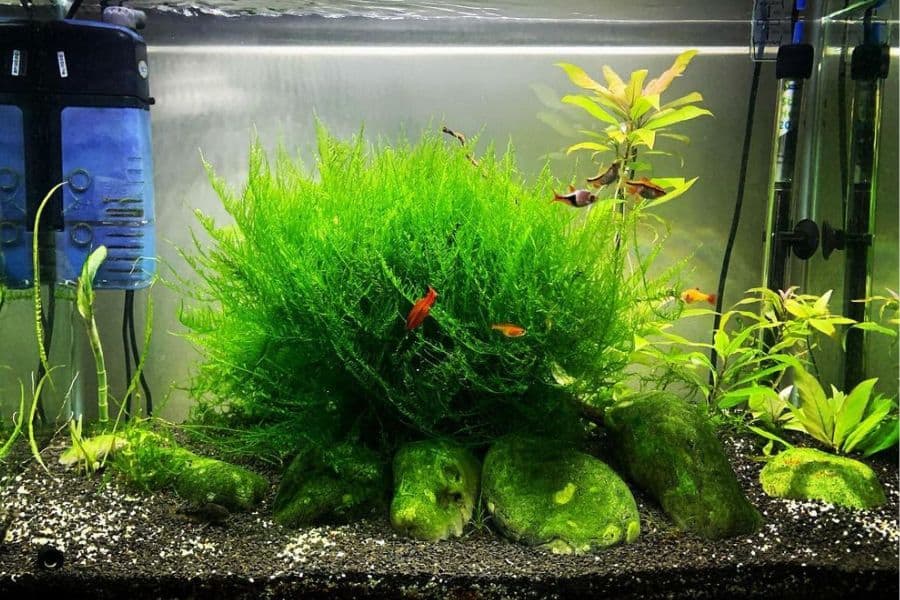
As the name suggests, Java Moss (Taxiphyllum barbieri) originated from the islands of Java and Sumatra in Indonesia, as well as other countries within Southeast Asia.
Aside from their utilization in traditional Asian medicine (as diuretics, cough medication, and wound dressing), Java Moss is valued more in the aquarium hobby as one of the sought-after plants for aquascaping.
Java Moss is a small plant standing only from 2 to 5 inches tall. It has multiple small stems that branch out irregularly with leaves that can only reach 2mm long.
Despite having no roots, Java Moss has sticky feet called rhizomes which are very effective in anchoring on any surface. This characteristic allows the plant to either carpet along the substrate, attached to driftwood, or set in the wall and become a background flora.
Being a perennial plant, Java Moss flourishes in all types of seasons, making them readily available all year round. On top of this, they reproduce sexually (by releasing spores) and asexually through the fragmentation of small buds that grows into a new plant.
Benefits of Keeping Java Moss
Aside from adding to the aesthetic beauty of your tank, keeping Java Moss comes with several benefits:
Stabilize Water Chemistry
As your fish metabolize and excrete, they release inorganic compounds like ammonia, nitrites, and nitrates. If these chemicals are not controlled and keep building up, they can become toxic and may wipe up your entire fish population.
With Java Moss, they favor these unwanted substances by absorbing them and converting them into energy for their growth and development. In other words, the more Java Moss you plant, the more stable your water chemistry is.
Supplement Oxygen Supply
Like other aquatic plants, Java Moss undergoes photosynthesis, taking in carbon dioxide and producing oxygen.
However, while their oxygen production occurs during the daytime or when exposed to light, the amount depends on the plant’s health, the length of light exposure, and the availability of carbon dioxide.
It’s important to note that Java Moss can only contribute to the oxygen supply in your tank, and relying solely on it for oxygen is insufficient. It can only supplement the oxygen produced by other sources in your tank.
Provide Refuge for Small Residents
If your aquarium is home to small inhabitants such as shrimp or tiny fish, it’s essential to provide them with cover and protection from larger, predatory fish. Without adequate shelter, they become easy targets for predators.
Fortunately, Java Moss is an excellent solution to this problem. While it may not create tall vegetation, it grows thick and dense, forming a natural barrier where small fish and shrimp can take refuge.
This foliage provides a secure hiding place for them while allowing larger fish to swim freely in open water. Java Moss creates a safe and comfortable environment for all your tank residents.
Different Planting Techniques for Aquascaping
Are you eager to explore the endless possibilities of Java Moss and experiment with various planting techniques?
Before you proceed, be reminded that Java Moss don’t have roots and rooting them will cause the plant to die. In the case of planting Java Moss, it means setting them on the substrate you want them to grow.
Create the perfect environment you want for your Java Moss by following these easy steps.
Carpeting Over Sand or Gravel
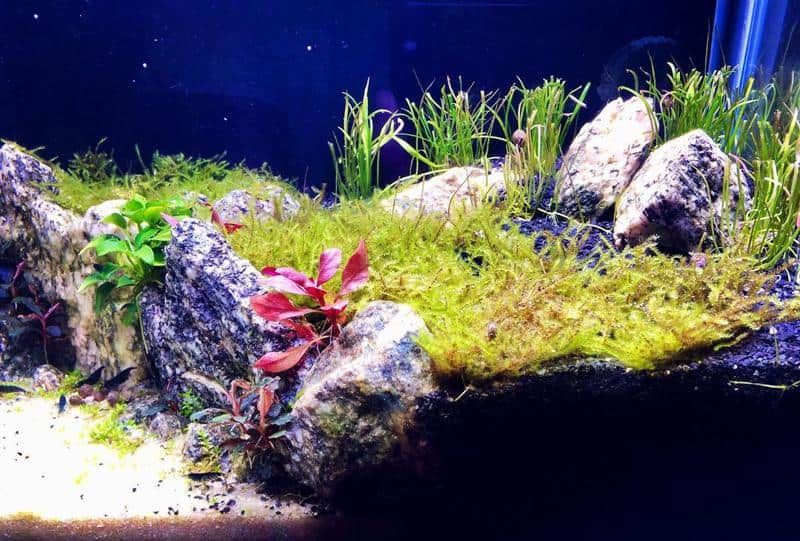
Java Moss is popularly used to create a carpet effect along the substrate.
Substrate Preparation
If you are setting up a new tank, it’s essential to rinse the substrate you choose before placing it in the tank and adding water.
In case you already have a fully set-up tank, all you need to do is vacuum clean your substrate to remove any dirt, debris and unconsumed foods.
Mesh Preparation
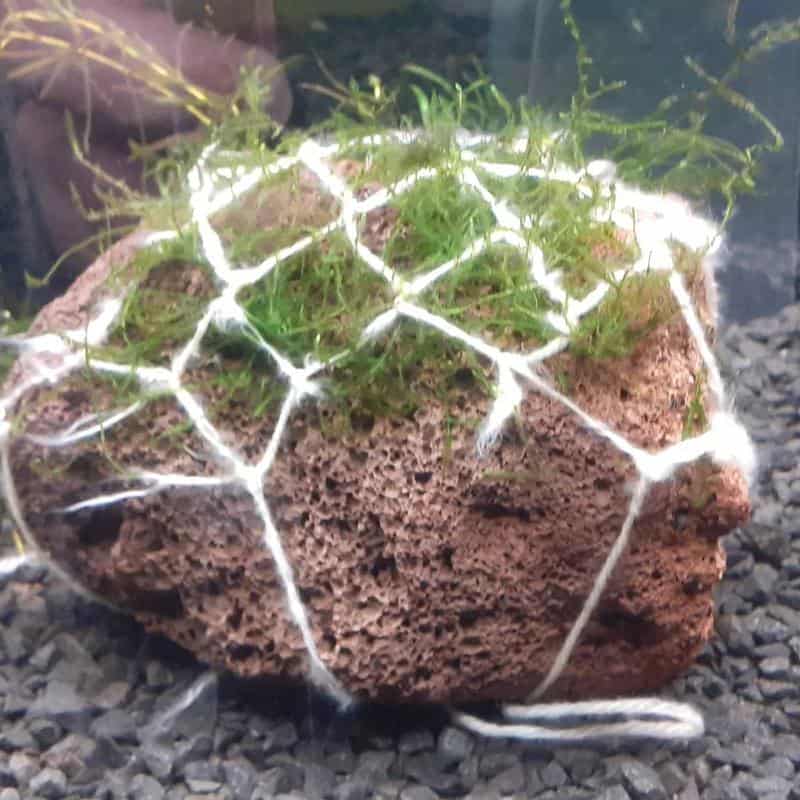
Since Java Moss cannot be buried and rooted down in the substrate, it will float if you simply place them on top. You should use a mesh to hold the plant in place.
There are many types of mesh, but we recommend the thin steel mesh since its weight can firmly hold your Java Moss.
Depending on the size of your tank, you can cut your steel mesh into several squares for easy handling. Place a corresponding amount of Java Moss on each square mesh and tie it with a thread. Arrange the square mesh with the Java Moss in the substrate until all grounds are covered or depending on how you want it to look.
If you purchased Java Moss that already comes in a mesh, you don’t need to do anything else except clean it before placing it in the substrate.
No Mesh Preparation
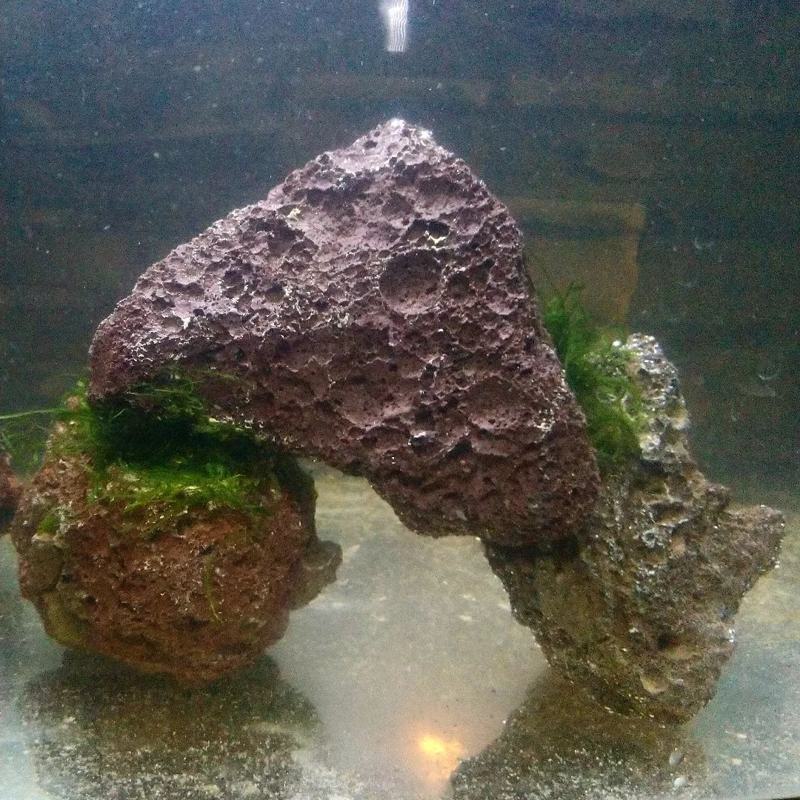
Some aquarists prefer not to use a mesh and instead create a depression in the substrate using their thumb. They then set the Java Moss on top of the depression and place a small rock or weight on it to hold it firmly.
The Java Moss will eventually grow over the rocks, so there’s no need to worry about their appearance.
Setting on Driftwood
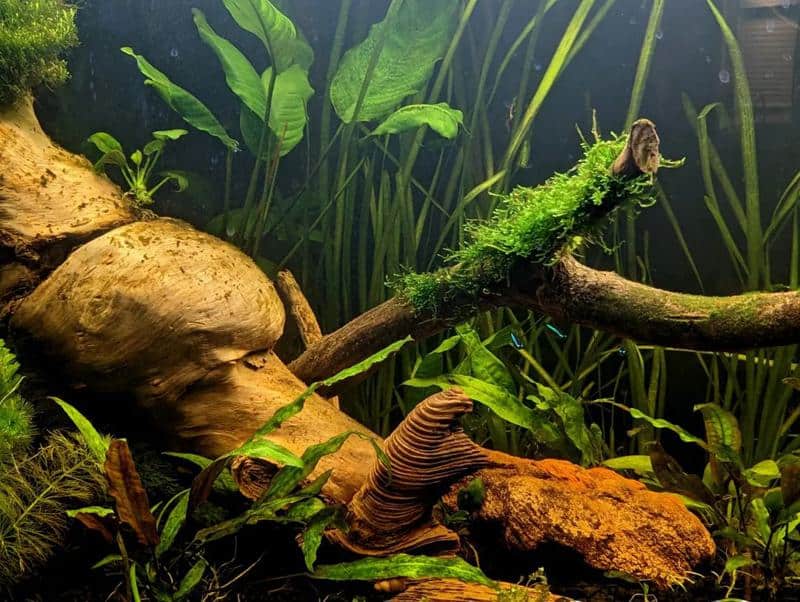
Combining Java Moss and driftwood creates one of the sought-after centerpieces in aquascaping – the Java Moss tree.
Selecting the Right Driftwood
Not all driftwoods are compatible with growing Java Moss. Get rid of driftwood with super smooth surfaces. Instead, select those that have a rough or porous texture. In this way, the rhizomes can easily anchor in the pores of the driftwood.
Once you have selected a driftwood, clean it against dust (if unused for a long time), dirt, and other debris.
Setting the Java Moss
Place the Java Moss on the part of the driftwood you want them to grow. To have a Java Moss tree, place them at the driftwood’s branching tops.
While you don’t use mesh in setting Java Moss in driftwood, tying and wrapping them with a thread will hold them in place.
Setting the Driftwood
Once you have set the Java Moss, you can place and set the driftwood in your tank. Since you are expecting to create a Java Moss tree, we recommend placing them at the center of your tank to become the main attraction once the Java Moss blooms.
Encrust on Stones
Encrusting Java Moss on stones is more challenging than driftwood since most surfaces are smooth.
Instead of using thread, applying a small amount of aquarium-safe glue will hold the plant firmly. Do not use a glue gun. The sticky solution produced by the glue gun is hot and will damage your Java Moss.
Similarly, if you allow it to cool down, it may be too late to set the Java Moss since the glue has already hardened.
Background Floral Wall
Making a background floral wall with Java Moss is like setting them in the substrate, except that the mesh is whole (not cut into small squares), and the orientation is vertical (rather than horizontal).
Create a whole mesh pad that is slightly smaller than the size of your tank wall. Spread your Java Moss across the mesh pad and secure them using thread.
Do not permanently stick the mesh pad in your tank. Instead, use vacuum pads to secure them in place and detach them easily once cleaning day arrives.
Free Floating
The most uncomplicated setting for Java Moss is for them to become floating plants. Just release them in the tank and allow them to float. 100% hassle-free.
Care and Maintenance of Java Moss
Considered as a low maintenance plant, caring for Java Moss is relatively easy. The fact is, they are so hardy that most aquarists leave them behind after setting.
However, it doesn’t mean that Java Moss is indestructible. They can still be affected, especially in poor water conditions.
Here are some care and maintenance that you can do for the optimal growth of your Java Moss.
Moderate Lighting
As commonly practiced, Java Moss are exposed to moderate lighting for 8 to 10 hours daily. But being a versatile plant, Java Moss can live on the extreme.
They can thrive in low-light environments or intense brightness, where it is often the light setting if you want them to grow fast and bloom into a vibrant greenery.
Nutrient Supplements
The nutrients absorbed from fish waste and unconsumed food are sufficient for Java Moss nutrition. However, you are required to add liquid fertilizer if you are keeping a lot of Java Moss.
Please do not use root tabs in providing additional nutrients for Java Moss. Remember that Java Moss don’t have roots, and the nutrients provided by the root tabs are only those diffused in the water column and not those enriched in the substrate.
Water Parameters
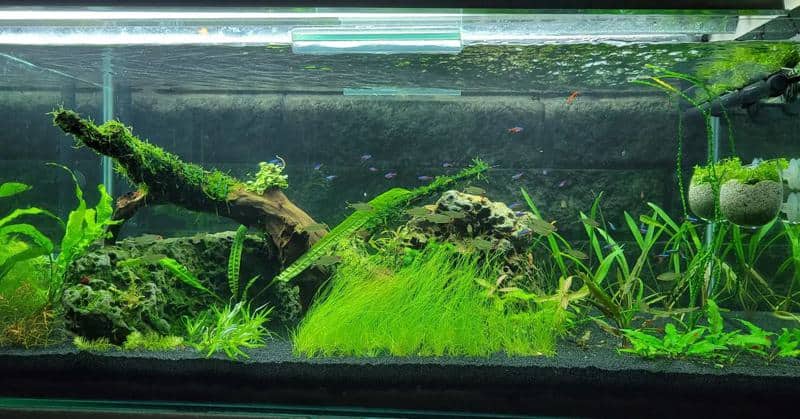
Outlined in the table below are the water parameters suitable for growing Java Moss.
| Parameters | Range |
| Temperature | 15 to 27 C (60 to 80 F) |
| pH | 5 to 8 |
| Hardness | 2 to 20 dGH |
| Ammonia | 0 – 0.25 ppm |
| Nitrite | <0.5 ppm |
| Nitrate | 10 to 25 ppm |
Trimming and Cleaning
After planting, there is nothing much to do with Java Moss except for two things.
When they grow tall, their foliage may not be visually pleasing anymore or have obstructed a part of your tank. By this time, you should trim your Java Moss to prevent obstruction and maintain its neatness.
While trimming is easy, cleaning them may need time and effort. Be aware that Java Moss is notorious for trapping sediment due to their filamentous growth. In cleaning them, you should carefully vacuum the sediments out, where in most cases, are embedded deeply in their foliage.
Propagation of Java Moss
Although Java Moss can reproduce sexually by releasing spores, it hardly happens in a tank setting.
Propagating Java Moss in the aquarium always employs asexual reproduction. It happens when they grow and spread their buds or plantlets that detach and form a new plant.
Keeping in mind their mode of asexual reproduction, propagating Java Moss comes out naturally. The plantlets you will use for propagation are the cuttings when you trim them during maintenance. Just be sure the cuttings are 2 inches long since it is the ideal length for replanting.
Once you have the cuttings, just plant and set them to the substrate you want them to grow using the methods described earlier. Expect growth to commence within a month.
Compatible Tank Mates for Java Moss
Java Moss is not just for shrimps, snails, and tiny fish. They perform well in community tanks. Here are some fish compatible with growing Java Moss:
- Neon tetra
- Guppy
- Betta fish
- Angelfish
- Platy
- Swordtail
- Cherry barb
- Kuhli loach
- Gouramy
- Zebra danio
- Harlequin rasboras
- and algae-eating fish like Siamese algae eaters, bristlenose plecos, and Chinese algae eaters
Also Read:
- Best Carpet Plants for Aquarium
- Best Easy Aquarium Plants for Beginners
- Low Light Aquarium Plants
- Best Aquarium Plants for a Sandy Substrate
- Dwarf Hairgrass
FAQs
How Fast Does Java Moss Grow?
Despite being hardy and versatile, Java moss is not a fast-growing plant. They take about a month to establish, and their growth rate can vary depending on several factors.
In optimal conditions, Java Moss can grow around 1 to 1.5 inches monthly. However, it’s essential to note that unfavorable conditions, such as poor water quality, can significantly impact the plant’s growth rate. Under such conditions, the growth rate of Java Moss may slow down considerably, leading to stunted growth or even death.
Can Java Moss Grow out Of the Water?
Yes, but only for a while, especially if they start to dry up. The key to their survival on dry land is a constant source of moisture.
In their wild environment, Java Moss grows out of the water by clinging to rocks near the water or roots of semi-aquatic plants. In this way, their water requirement is always met.
Why Does My Java Moss Turn Brown?
There are several reasons why your Java Moss is turning brown, like insufficient or too much lighting, lack of nutrients, poor water quality, and natural aging.
Be aware that the brown discoloration is the initial response of Java Moss, and if the problem is not addressed on time, your Java Moss may die.
Conclusion
It is without a doubt that Java Moss is highly versatile. They can be set according to your preference, which you cannot do to other aquatic plants. It is their secret why they are listed as one of the most popular freshwater aquarium plants.
But you have to be patient with Java Moss. It takes time for them to grow and bloom. However, when they establish themselves and start flourishing, your patience will be rewarded as you realize and affirm with us how elegant Java Moss are.